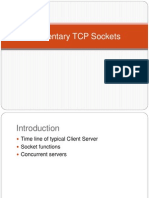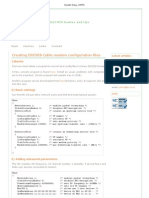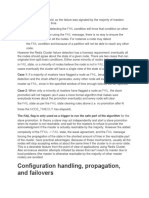Professional Documents
Culture Documents
Redis Cluster Specification-12
Redis Cluster Specification-12
Uploaded by
Kajaruban SurendranOriginal Description:
Copyright
Available Formats
Share this document
Did you find this document useful?
Is this content inappropriate?
Report this DocumentCopyright:
Available Formats
Redis Cluster Specification-12
Redis Cluster Specification-12
Uploaded by
Kajaruban SurendranCopyright:
Available Formats
A Redis client is free to send queries to every node in the cluster, including slave nodes.
The node will analyze the query, and if it is acceptable (that is, only a single key is
mentioned in the query, or the multiple keys mentioned are all to the same hash slot) it
will lookup what node is responsible for the hash slot where the key or keys belong.
If the hash slot is served by the node, the query is simply processed, otherwise the
node will check its internal hash slot to node map, and will reply to the client with a
MOVED error, like in the following example:
GET x
-MOVED 3999 127.0.0.1:6381
The error includes the hash slot of the key (3999) and the ip:port of the instance that
can serve the query. The client needs to reissue the query to the specified node's IP
address and port. Note that even if the client waits a long time before reissuing the
query, and in the meantime the cluster configuration changed, the destination node will
reply again with a MOVED error if the hash slot 3999 is now served by another node.
The same happens if the contacted node had no updated information.
So while from the point of view of the cluster nodes are identified by IDs we try to
simplify our interface with the client just exposing a map between hash slots and Redis
nodes identified by IP:port pairs.
The client is not required to, but should try to memorize that hash slot 3999 is served by
127.0.0.1:6381. This way once a new command needs to be issued it can compute the
hash slot of the target key and have a greater chance of choosing the right node.
An alternative is to just refresh the whole client-side cluster layout using the CLUSTER
NODES or CLUSTER SLOTS commands when a MOVED redirection is received.
When a redirection is encountered, it is likely multiple slots were reconfigured rather
than just one, so updating the client configuration as soon as possible is often the best
strategy.
Note that when the Cluster is stable (no ongoing changes in the configuration),
eventually all the clients will obtain a map of hash slots -> nodes, making the cluster
efficient, with clients directly addressing the right nodes without redirections, proxies or
other single point of failure entities.
A client must be also able to handle -ASK redirections that are described later in this
document, otherwise it is not a complete Redis Cluster client.
Cluster live reconfiguration
Redis Cluster supports the ability to add and remove nodes while the cluster is running.
Adding or removing a node is abstracted into the same operation: moving a hash slot
You might also like
- Hcia Datacomm QuestionDocument10 pagesHcia Datacomm QuestionJumput PurnomoNo ratings yet
- Switching Interview Questions and Answers Vol 1.0Document14 pagesSwitching Interview Questions and Answers Vol 1.0Eduardo AguilarNo ratings yet
- HCIA Datacom Mock Exam 1.0 PDFDocument18 pagesHCIA Datacom Mock Exam 1.0 PDFyomif tamiru100% (1)
- Complete Beginner's Guide To Processing Whatsapp Data With PythonDocument9 pagesComplete Beginner's Guide To Processing Whatsapp Data With PythonLucianoNo ratings yet
- Redis Cluster Specification-19Document1 pageRedis Cluster Specification-19Kajaruban SurendranNo ratings yet
- Redis Cluster Tutorial-1Document3 pagesRedis Cluster Tutorial-1Kajaruban SurendranNo ratings yet
- Redis ClusterDocument17 pagesRedis Cluster최현준50% (2)
- Data Transmission Using Multi-Tasking-Sockets AbstractDocument6 pagesData Transmission Using Multi-Tasking-Sockets AbstractTelika RamuNo ratings yet
- Redis Cluster Specification-15Document1 pageRedis Cluster Specification-15Kajaruban SurendranNo ratings yet
- Redis Cluster Specification-18Document1 pageRedis Cluster Specification-18Kajaruban SurendranNo ratings yet
- CH2 6TISCH Adaptation LayerDocument9 pagesCH2 6TISCH Adaptation LayerSakata GintokiNo ratings yet
- HICA Datacom 02Document10 pagesHICA Datacom 02Asma ElmangoushNo ratings yet
- PArt 5+6 - QDocument36 pagesPArt 5+6 - Qalecs.jonNo ratings yet
- 350 018Document350 pages350 018George GeorgescuNo ratings yet
- Ihlp Report PDFDocument12 pagesIhlp Report PDFDipika GhoshNo ratings yet
- Promox 2Document101 pagesPromox 2Rodrigo PinzonNo ratings yet
- AF-6 Series Drives Modbus RTUDocument12 pagesAF-6 Series Drives Modbus RTUshijub_001No ratings yet
- Switching - Support - Stage 3 QuizDocument9 pagesSwitching - Support - Stage 3 QuizClark TangNo ratings yet
- Analysis of The 802.11s Mesh TechnologyDocument40 pagesAnalysis of The 802.11s Mesh Technologyabhisheksingh2No ratings yet
- Socket Prog With CDocument12 pagesSocket Prog With CGourab BanikNo ratings yet
- Mac Reliable Broadcast in Ad Hoc NetworksDocument6 pagesMac Reliable Broadcast in Ad Hoc NetworkscagtyNo ratings yet
- Ch-4 - TRANSPORT LAYERDocument105 pagesCh-4 - TRANSPORT LAYERShivang negiNo ratings yet
- Network Address Translation (NAT) & Load BalancingDocument57 pagesNetwork Address Translation (NAT) & Load BalancingNikhil TripathiNo ratings yet
- Learning Outcomes Questions 1 (30 Marks) 2,3 (35 Marks) : Hardware, Software, Systems & Networks Exam Review AnswersDocument4 pagesLearning Outcomes Questions 1 (30 Marks) 2,3 (35 Marks) : Hardware, Software, Systems & Networks Exam Review AnswersAnishNo ratings yet
- 4.6 Case Study: Interprocess Communication in UNIXDocument4 pages4.6 Case Study: Interprocess Communication in UNIX35rajNo ratings yet
- Tritex Modbus ProtocolDocument20 pagesTritex Modbus ProtocolSocaciu VioricaNo ratings yet
- HCIA - QuestionsDocument4 pagesHCIA - QuestionsFernando CostaNo ratings yet
- Notes3 Note PDFDocument78 pagesNotes3 Note PDFsycuneNo ratings yet
- Jawaban MTCNADocument13 pagesJawaban MTCNAAlpredo PandianganNo ratings yet
- Please Answer The Questions With The Best Response From Class Lectures and The TextbookDocument7 pagesPlease Answer The Questions With The Best Response From Class Lectures and The Textbookfe airam dakigNo ratings yet
- Charm 1Document27 pagesCharm 1Daniel LaiNo ratings yet
- Kubernetes Flannel NetworkDocument6 pagesKubernetes Flannel Networksuhashis acharyaNo ratings yet
- Internet and Internet Protocol Suite: Version 1 ECE, IIT KharagpurDocument7 pagesInternet and Internet Protocol Suite: Version 1 ECE, IIT KharagpurchandruNo ratings yet
- Assignment Correct SolutionsDocument3 pagesAssignment Correct Solutionsernestwriters20No ratings yet
- CompTIA PracticeTest N10-006 v2017-02-04 by Andrew 254qDocument112 pagesCompTIA PracticeTest N10-006 v2017-02-04 by Andrew 254qAdrian Jmurco100% (1)
- A DNS Message Format Contains 5 SectionsDocument6 pagesA DNS Message Format Contains 5 SectionsMohammad Asyraf RidzuanNo ratings yet
- JuneDocument17 pagesJunecyraxmacbookNo ratings yet
- Computer Networks and Protocols AnswersDocument46 pagesComputer Networks and Protocols AnswersRanjit BichukaleNo ratings yet
- Frame Relay TutorialDocument7 pagesFrame Relay TutorialSajith SubrahmanyanNo ratings yet
- HTTP - Header FieldsDocument17 pagesHTTP - Header Fieldsgaxiwap252No ratings yet
- TCP HeaderDocument8 pagesTCP HeaderNeenu PrasannanNo ratings yet
- Applies To:: Solaris Cluster How To Changing Cluster Interconnect IP Addresses (Doc ID 1012078.1)Document3 pagesApplies To:: Solaris Cluster How To Changing Cluster Interconnect IP Addresses (Doc ID 1012078.1)cresmakNo ratings yet
- Resume For Frame RelayDocument7 pagesResume For Frame RelaySenan AlkaabyNo ratings yet
- HCIA Datacom Exam 50 Q & Answers + ExplainationDocument42 pagesHCIA Datacom Exam 50 Q & Answers + ExplainationMohamed ElsadanyNo ratings yet
- Self - Exam.engine - Cisco.350 018.Exam.Q.and.a.13.06.06 ARNEBOOKDocument197 pagesSelf - Exam.engine - Cisco.350 018.Exam.Q.and.a.13.06.06 ARNEBOOKjitendra_dausaNo ratings yet
- Chapter 2 CommunicationDocument59 pagesChapter 2 CommunicationAbby JenningsNo ratings yet
- Data Communication Network MCQDocument5 pagesData Communication Network MCQMd Siraj UddinNo ratings yet
- Elementary TCP SocketsDocument71 pagesElementary TCP Socketssubramanyam62No ratings yet
- Modbus RTU Communication Protocol Between ELCDocument7 pagesModbus RTU Communication Protocol Between ELCjuan_pcnNo ratings yet
- Unix Socket Programming1Document7 pagesUnix Socket Programming1rahul khannaNo ratings yet
- Chapter3 SummaryDocument42 pagesChapter3 Summaryandrewakram57No ratings yet
- Open Modbus TCP SpecificationsDocument24 pagesOpen Modbus TCP SpecificationsAssia IaqbalNo ratings yet
- Frame Relay TutorialDocument9 pagesFrame Relay TutorialplanifikuesiNo ratings yet
- Telecommunication Protocols Questions and AnswersDocument3 pagesTelecommunication Protocols Questions and AnswersHitesh ShastryNo ratings yet
- Howto Linux, CMTSDocument9 pagesHowto Linux, CMTSGeorgi MakedonskiNo ratings yet
- CS 342 - Assignment 3 - September - 2022 - Reliable TransportDocument4 pagesCS 342 - Assignment 3 - September - 2022 - Reliable TransportSandeep MantriNo ratings yet
- WAN TECHNOLOGY FRAME-RELAY: An Expert's Handbook of Navigating Frame Relay NetworksFrom EverandWAN TECHNOLOGY FRAME-RELAY: An Expert's Handbook of Navigating Frame Relay NetworksNo ratings yet
- Configuration of Postfix Mail Server Supporting Anti Spam and Anti VirusFrom EverandConfiguration of Postfix Mail Server Supporting Anti Spam and Anti VirusNo ratings yet
- Starting Guide for Postfix Mail Server Configuration Supporting Anti Spam and Anti VirusFrom EverandStarting Guide for Postfix Mail Server Configuration Supporting Anti Spam and Anti VirusNo ratings yet
- Lakshmi Sahasranama Stotram - Hindupedia, The Hindu Encyclopedia PDFDocument36 pagesLakshmi Sahasranama Stotram - Hindupedia, The Hindu Encyclopedia PDFKajaruban SurendranNo ratings yet
- Redis Cluster Specification-20Document1 pageRedis Cluster Specification-20Kajaruban SurendranNo ratings yet
- Redis Cluster Specification-24Document1 pageRedis Cluster Specification-24Kajaruban SurendranNo ratings yet
- Redis Cluster Specification-27Document1 pageRedis Cluster Specification-27Kajaruban SurendranNo ratings yet
- Redis Cluster Specification-26Document1 pageRedis Cluster Specification-26Kajaruban SurendranNo ratings yet
- Redis Cluster Specification-23Document1 pageRedis Cluster Specification-23Kajaruban SurendranNo ratings yet
- Redis Cluster Specification-25Document1 pageRedis Cluster Specification-25Kajaruban SurendranNo ratings yet
- Redis Cluster Specification-21Document1 pageRedis Cluster Specification-21Kajaruban SurendranNo ratings yet
- Redis Cluster Specification-22Document1 pageRedis Cluster Specification-22Kajaruban SurendranNo ratings yet
- Redis Cluster Specification-11Document1 pageRedis Cluster Specification-11Kajaruban SurendranNo ratings yet
- Redis Cluster Specification-5 PDFDocument1 pageRedis Cluster Specification-5 PDFKajaruban SurendranNo ratings yet
- Redis Cluster Specification-18Document1 pageRedis Cluster Specification-18Kajaruban SurendranNo ratings yet
- Redis Cluster Specification-14Document1 pageRedis Cluster Specification-14Kajaruban SurendranNo ratings yet
- Redis Cluster Specification-3Document1 pageRedis Cluster Specification-3Kajaruban SurendranNo ratings yet
- Redis Cluster Tutorial-3Document3 pagesRedis Cluster Tutorial-3Kajaruban SurendranNo ratings yet
- Redis Cluster Tutorial-11Document2 pagesRedis Cluster Tutorial-11Kajaruban SurendranNo ratings yet
- Redis Cluster Specification-9 PDFDocument1 pageRedis Cluster Specification-9 PDFKajaruban SurendranNo ratings yet
- Redis Cluster Specification-2Document1 pageRedis Cluster Specification-2Kajaruban SurendranNo ratings yet
- Redis Cluster Tutorial-6Document3 pagesRedis Cluster Tutorial-6Kajaruban SurendranNo ratings yet
- Redis Cluster Tutorial-9Document3 pagesRedis Cluster Tutorial-9Kajaruban SurendranNo ratings yet
- Android - How To Add A Footer View (TextView) To The End of A ListView - Stack OverflowDocument2 pagesAndroid - How To Add A Footer View (TextView) To The End of A ListView - Stack OverflowfakkeloginNo ratings yet
- Manual de Servicio 750KWDocument137 pagesManual de Servicio 750KWMartin CalderonNo ratings yet
- Smart Nano Drone: Quick Start GuideDocument6 pagesSmart Nano Drone: Quick Start GuideFrainlynNo ratings yet
- Strategic Outsourcing at Bharti AirtelDocument15 pagesStrategic Outsourcing at Bharti AirtelShiva Kumar 91No ratings yet
- Wireless Sensor NetworksDocument9 pagesWireless Sensor Networksgayas41633% (3)
- List of BooksDocument37 pagesList of BooksupenderNo ratings yet
- Tabla Alerta UPSDocument18 pagesTabla Alerta UPSWalter Achaya LevaNo ratings yet
- Computing q1 85Document11 pagesComputing q1 85Yoo JungNo ratings yet
- Paul Furgale ThesisDocument5 pagesPaul Furgale Thesisygadgcgld100% (1)
- Arabic Fake News Detection Comparative Study of NeDocument10 pagesArabic Fake News Detection Comparative Study of Neasmaa hanafyNo ratings yet
- Suavización Exponencial ABC Wms ForecastDocument19 pagesSuavización Exponencial ABC Wms ForecastKarenziitah Katiuska Sosa RamirezNo ratings yet
- Westinghouse WGen7500DF Spec SheetDocument2 pagesWestinghouse WGen7500DF Spec SheetgusmilexaNo ratings yet
- Remote Sensing Techniques and GIS - Lecture Notes, Study Material and Important Questions, AnswersDocument5 pagesRemote Sensing Techniques and GIS - Lecture Notes, Study Material and Important Questions, AnswersM.V. TV100% (1)
- Chapter 4 - ProgrammingDocument58 pagesChapter 4 - ProgrammingMOHD SABREENo ratings yet
- Production SystemDocument20 pagesProduction SystemBaburaj ChoudharyNo ratings yet
- Abhilash Bajpai ReportDocument46 pagesAbhilash Bajpai ReportStudy BuddyNo ratings yet
- General Timing Chart / General Circuit Diagram: Ir6570/5570 SeriesDocument36 pagesGeneral Timing Chart / General Circuit Diagram: Ir6570/5570 Seriesfkolansinsky75% (4)
- Installation Wallbox Plus ECEDocument68 pagesInstallation Wallbox Plus ECEihor.rudyk.mmeba.2022No ratings yet
- Excel C#Document39 pagesExcel C#Bhuvnesh PandeyNo ratings yet
- Medical Management SystemDocument5 pagesMedical Management SystemArbad maheshNo ratings yet
- CombiGauge Operating Maintenance Instructions PDFDocument27 pagesCombiGauge Operating Maintenance Instructions PDFDanil1212 Danil2121100% (3)
- E3 Plus To E300 MigrationDocument8 pagesE3 Plus To E300 MigrationNixiusNo ratings yet
- AVCS User Guide For L 3 Valmarine NaviNet ECDIS v1 0Document38 pagesAVCS User Guide For L 3 Valmarine NaviNet ECDIS v1 0Lyubomir Lazarov100% (1)
- Agile in Remote WorkDocument2 pagesAgile in Remote Workharry.hopps1992No ratings yet
- RM ProjectDocument72 pagesRM Projectraj odiyarNo ratings yet
- Veta 5 - Datasheet - ENG - 20210315Document3 pagesVeta 5 - Datasheet - ENG - 20210315JuanNo ratings yet
- Blain EV Troubleshooting Ev - Trouble-GbDocument2 pagesBlain EV Troubleshooting Ev - Trouble-GbSylvester SullivanNo ratings yet
- Cyber Security UpdateDocument4 pagesCyber Security UpdateEuglena VerdeNo ratings yet
- Mo Nice TsCsDocument2 pagesMo Nice TsCsMziyanda Boet-Bhayi ShumîNo ratings yet












































































































